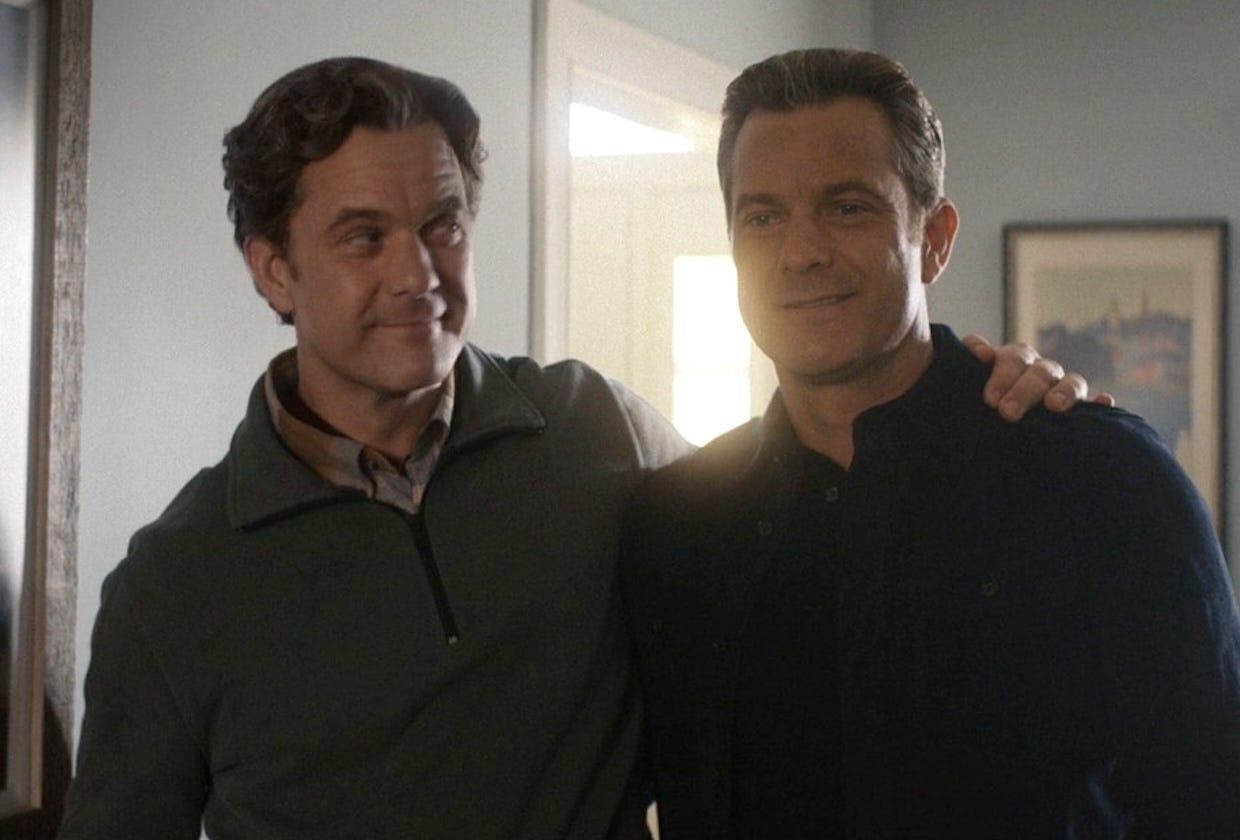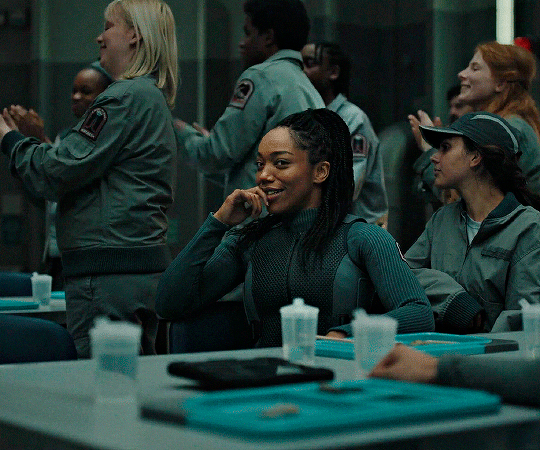These are the last few days that I’m offering 30% off a year of paid subscriptions! That’s $3.5/month, or $35/year. It’s a great deal, but you have to act now!
It’s not just Michael B. Jordan. Hollywood in general seems to be in what
called their Lindsay Lohan era. I’ve seen three 2025 movies so far—Sinners, Mickey 17, and The Monkey—with the lead playing his own twin or clone. Rachel Weisz recently played her own twin in the mini-series remake of Dead Ringers. Janelle Monae and her accent work twinned it up in Glass Onion: A Knives Out Mystery. The characters on Severance share a body with their severed inner selves, and have some core personality traits—though not memories, not souls—in common. Cynthia Erivo, never one to do it small, is playing septuplets in an upcoming episode of Peacock’s Poker Face.The earliest dual role performance I remember seeing was 1961’s The Parent Trap, which the Disney Channel helpfully and repeatedly told me starred Hayley Mills and Hayley Mills.1 But by the time Bette Davis did it for the second time, in 1964, filmmakers had been working to perfect the twin effect for over 60 years. The earliest instance of an actor doubling on-screen was in 1898, in Georges Méliès’s short un homme des têtes.
So yes, the twin effect has been a thing in movies pretty much since movies became a thing. But as far as I know, it’s never been so popular as it is now. We can chalk some of this up to technological advances, so filmmakers are no longer dependent on cumbersome things like matte paintings and static cameras.2 But three points make a line, and a line is a trend, so something else is up. There’s a fixation at work here.
Spoilers for Severance, Mickey 17, Sinners, The Monkey, and Dead Ringers ensue. Feel free to switch with your innie, and please enjoy each spoiler equally.
First, we have to make a distinction. There are dual performances where the actor is playing twins—people who have always organically existed as two. And then there are dual performances where the actor is playing versions of the same person—people who have been copied, or split apart, with some kind of scientific intervention. There’ll still be some overlap as I investigate themes and whatnot, but twins and clones represent some different anxieties and possibilities.
Possibilities like splitting yourself into two or more selves, for instance. Severance shows us a world where we’ve harnessed but not yet mastered the power to split our consciousness into pieces, and then send one of those pieces off to do the things we’d rather skip. For the middle class, that skippable thing is, of course, working a mindless office job. For the elite, the list of skippable things includes childbirth. But we know from the very beginning of the show that this kind of frictionless existence is too good to be true. That all of the convenience is made possible by labor, pain, and effort that’s made invisible, done by people who are made to matter less.
Similarly, Mickey 17 concerns an “expendable” worker named Mickey, who earns his keep on an Earth-fleeing spaceship by letting his overseers trick him into cruelly painful deaths, then reprinting him and inserting his memories into the latest copy. When Mickey 17 accidentally survives one of his death missions, he returns to his bunk to find an immediately hostile Mickey 18. Since duplicates are outlawed on this spaceship, one of them has to die or they’ll both be executed. 18, who is much more confident and defiant than the cautious and deferential 17, argues that he hasn’t been able to experience any life yet and therefore shouldn’t be the one to die. For his part, 17 is newly terrified by his own mortality. His consciousness has felt uninterrupted because he would always wake up from death with his memories intact. But if he dies while the next version of him is already alive, it will feel like dying for real.
To further complicate matters, 18’s existence doesn’t just threaten 17’s life, but his sense of self. Since 18 is so confident and relatively carefree, he seems like a hotter, cooler, better Mickey altogether. A Mickey who might make more sense with his impossibly hot and cool girlfriend than 17 does.
And again, it’s a similar threat that Severance’s Dylan faces with his innie, Dylan G. Dylan G is the most perk-motivated employee on the severed floor, and we understand why once we get a fuller picture of his home life. Out in the real world, Dylan has floundered. At Lumon Industries, he’s “this super-confident badass,” as he puts it. So when his wife confesses to starting a physical relationship with his innie, Dylan feels rejected in favour of the more impressive version of himself. (I got into how this all played out in much more detail here!) That desire for ease awakens an existential fear, that a better version of you could make you irrelevant.
Of course, the allure of having a real twin is the intimacy. Rather than an automatic opp, this person couldn’t be more of a Day One. It’s the kind of bond that can’t be replicated, hence the hostility between on-screen clones and duplicates; and can’t be replaced by any other connection. In every millennial’s favourite example, once Annie and Hallie stop their prank war and accept the obvious—that they are twin sisters with genuinely psychotic parents—they’re immediately inseparable. They concoct some kinda parent trap scheme that really only makes sense to them, so that they don’t have to be apart again. Even though they’re complete opposites personality-, style-, and accent-wise, they complement each other quite lovingly. they’re the platonic ideal of movie twins.
What’s the word for the opposite of the platonic ideal? Whatever it is, is what The Monkey’s Bill and Hal are. I know it was a black comedy, but I felt genuinely aggrieved at how much these twins hated each other. They hate each other so much that a preteen Hal tries to use their cursed monkey toy3 to kill his brother Bill. His attempted fratricide turns into an accidentally successful matricide, with the evil monkey instead killing their mother right in front of Bill. As adults, Hal has become an ostentatiously frumpy recluse and deadbeat dad, claiming to be an only child; while Bill has dedicated his life to obsessively worshipping the evil monkey and longing to avenge his mother’s murder by murdering his brother. They have all of the intimacy, and none of the closeness. Hal has to remind Bill that he also lost his mother, and has spent his life mourning her just as Bill has. They know each other well enough to hate and hurt each other, but all that hate and hurt prevents them from ever really seeing each other. It’s the loneliest twin depiction I’ve ever seen.
Which brings me back to Michael B. Jordan and Michael B. Jordan, the smokeshow Smokestack twins of Sinners. Smoke and Stack aren’t lonely at all. They’re brimming with love for each other, for their little cousin Sammie, and for the women in their lives. Smoke’s love, Annie, is a hoodoo practitioner with whom he shares the grief of their dead child. Stack’s love, Mary, is a Tragic Mulatto™️ who seems determined to not understand that her apparent whiteness brings to everyone around her. But love and desire make you vulnerable, and this is a vampire movie. And if vampires will do one thing, it’s prey on your vulnerabilities.
Mary’s love for Stack and need to feel useful rather than burdensome are her vulnerabilities, and that’s how she gets turned. Stack’s love and desire for her is how he gets turned. And the vampirism that turns Stack is also what curdles his love for his brother into something selfish and possessive. Stack wants Smoke to join him as a vampire, and so feeds on Annie as a way to further entice him to their side. But he doesn’t know the promise Smoke made to Annie, to kill her before she became a monster. Or the promise that Smoke and Annie had made to each other and their baby, that they would be together again in the afterlife. Stack didn’t know that he was breaking his own heart, along with Smoke’s. No one has the power to hurt you like your kin.
When Stack bleeds out in Smoke’s arms, before he comes back as a vampire, Smoke unravels for the first time. “He’s the best thing about me,” he weeps. In Dead Ringers, as she decides to die, Rachel Weisz says to Rachel Weisz, “You always were a better me.” These twins aren’t afraid of being made redundant by the better version of themselves. They’re finding the pursuit of happiness, of a full and fully realized life, impossible. In some cases, like in The Monkey, they can’t live with each other. In more cases, they can’t live without each other. In all cases, only one twin makes it out.
These movie monsters don’t represent the fear of the other. Instead of creatures that look pointedly inhuman, like the biblically accurate angel of NOPE or the spidery critters of the Cloverfield era, we’re getting monsters who look just like us and think just like us because they are us. The scariest thing we can imagine is us.
It feels like the perfect fear for this extremely solipsistic era we’re currently in. How do you scare a people whose default setting is rejecting community? Tell them that the real horror is within, not without. Tell them that they can’t trust themselves or the devil inside them. Tell them that there’s no compartmentalizing their way to inner peace, because something inside them will always sabotage that peace.
Scary, right?
My dumb ass really thought their parents named them both Hayley, I guess so they could save time? Kid logic.
We are, as ever, still dependent on stunt and body doubles!
Not a toy. Don’t call it a toy. It’s an infernal son of a whore, according to Captain Adam Scott.











I thought one of them was named Hayley and the other one was named Mills. Kid logic!